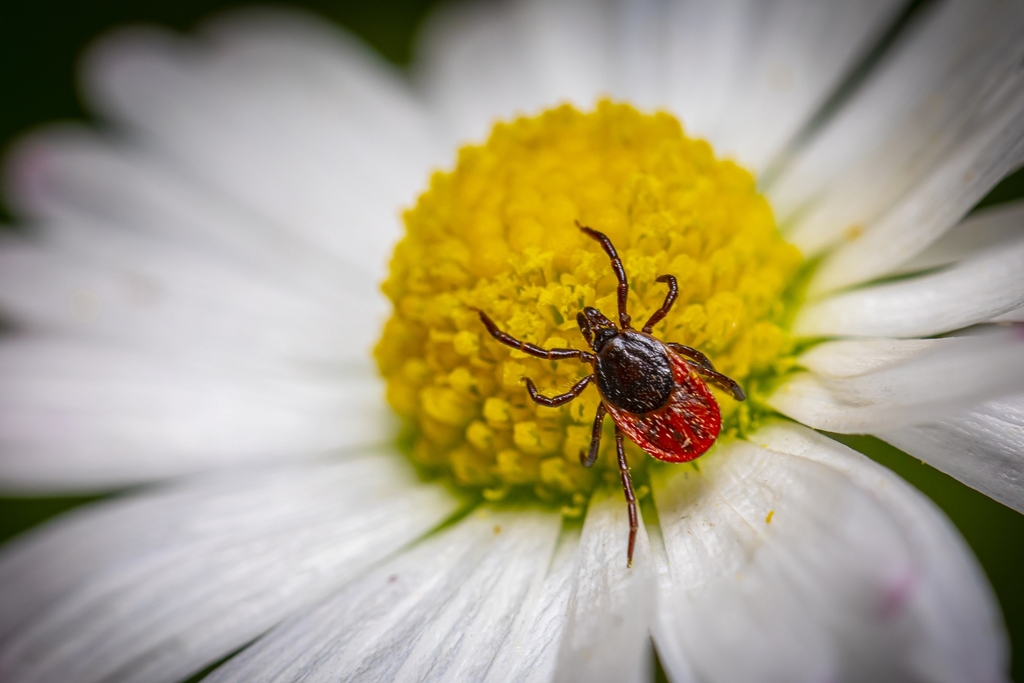Written by Daria Sysoeva and Edited by Mehr Kaur Bawa

Though seemingly harmless, ticks can be very dangerous in certain situations. In particular, a deer tick infected with the bacteria B. burgdorferi can cause Lyme disease through a small bite of a wide variety of hosts, including humans. After entering the skin, the bacteria travels through the bloodstream by creating and breaking bonds with the cells that form the blood vessel lining. This mechanism allows the bacteria to travel throughout the body, causing illness [1]. Depending on how many days have passed since the onset of the infected tick bite, Lyme disease may enter one of three stages: early localized disease, early disseminated disease, and late disseminated disease [2].
Within thirty days of the infected tick bite, the infection may be in the early localized disease stage. A hallmark symptom of this stage is the “bulls-eye” rash, which looks like a flat, red circle on the skin. Along with this rash, the patient may also experience joint pain and fever. In the early localized stage of infection, Lyme disease may be cured but because antibodies against Lyme disease take about two weeks to develop, the infection may be difficult to diagnose with existing laboratory tests, which rely on detecting antibodies [3] [4].
If the Lyme disease remains untreated within three months after the infected tick bite, then the infection may progress onto the early disseminated disease stage in which life threatening conditions affecting the heart and central nervous system may develop [5]. In particular, the B. burgdorferi bacteria may damage the facial nerve and lead to facial paralysis [2]. Moreover, if the B. burgdorferi infiltrates heart tissue, Lyme carditis may develop in which infected individuals may experience irregular heartbeat because the bacteria blocks transmission of electrical signals from one part of the heart to the other [6]. In the late stage of this disease, three months after initial exposure, a condition called Lyme Arthritis, which is characterized by inflammation of large joints, may develop [4].
While Lyme disease is in its early stages, it can be cured by taking an antibiotic treatment plan that lasts for approximately 14 to 21 days [7]. Intravenous antibiotics, or antibiotics that are administered through the veins, are recommended for individuals who have developed central nervous system infections from Lyme disease [7]. However, even after antibiotic treatment, symptoms of Lyme disease such as fatigue, muscle pain, and brain fog may still occur. If these symptoms persist for six months even after laboratory testing does not detect the presence of an active Borrelia burgdorferi infection, then the patient is said to have Post Lyme Disease Syndrome [3,4].
Lyme disease is currently an active field of research. As such, the underlying cause of persistent lyme disease symptoms even after completion of an antibiotic treatment is still being studied. Additionally, scientists are continuously searching to improve detection of the bacteria even when it is in the early stages without the production of antibodies.
References
- Cell Press. “How Lyme disease bacteria spread through the body.” ScienceDaily, ScienceDaily, 2016, https://www.sciencedaily.com/releases/2016/08/160825130027.htm#:~:text=%22The%20ability%20of%20Lyme%20disease,the%20barrier%20to%20dissemination%20caused. Accessed 20 Apr. 2021.
- Hatchette, T.F., Davis, I., Johnston, B.L. (2014). Lyme Disease: clinical diagnosis and treatment. Canada Communicable Disease Report, 40: 194-208.
- Lindsay, L.R., Bernat, K., Dibernardo, A. (2014). Laboratory diagnostics for Lyme disease. Canada Communicable Disease Report, 40: 2019-217.
- “Current Efforts in Lyme Disease Research, 2019 Update.” NIH, 2019, https://www.niaid.nih.gov/sites/default/files/NIAIDLymeReport.pdf
- Murray, T.S., Shapiro, E.D., (2013). Lyme Disease. Clinics in Laboratory Medicine, 30: 311-328.
- “Lyme Carditis.” Treatment, Centers for Disease Control and Prevention, 2020, https://www.cdc.gov/lyme/treatment/lymecarditis.html. Accessed 20. Apr. 2021.
- “Lyme Disease.” Diagnostics and Treatment, Mayo Clinic, 2020, https://www.mayoclinic.org/diseases-conditions/lyme-disease/diagnosis-treatment/drc-20374655#:~:text=A%2014%2D%20to%2021%2Dday,for%2014%20to%2028%20days. Accessed 20. Apr. 2021.